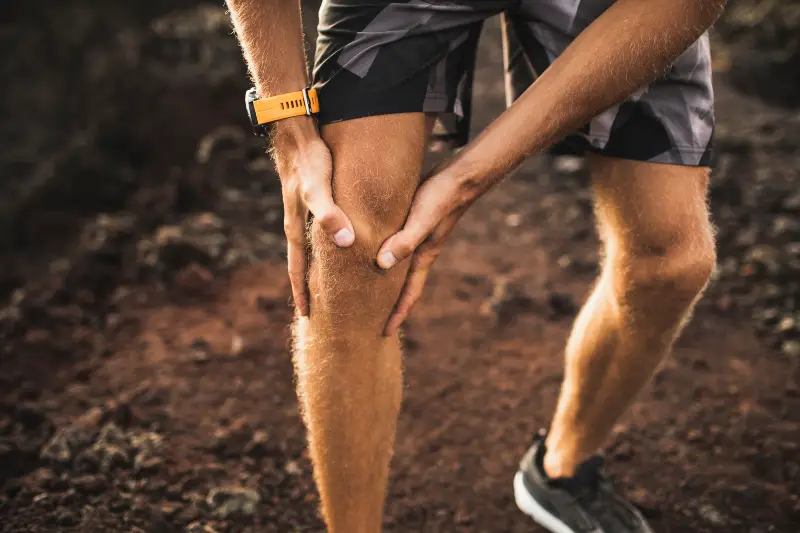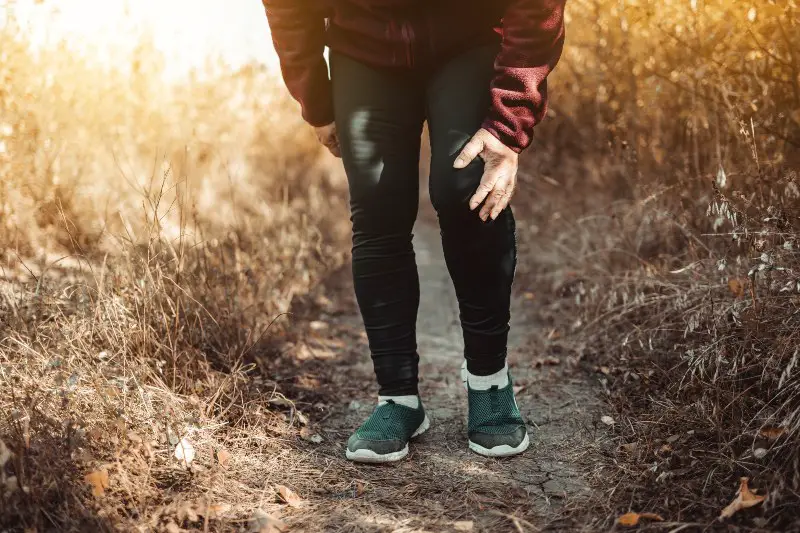Last Updated on May 13, 2023 by
When hunting in the mountains, it is common to experience knee pain. This can be due to the strenuous terrain and long hours of walking, an injury, or possibly other conditions like osteoarthritis.
Luckily, there are several strategies you can use to help manage knee pain while out on your hunt. Some of the most effective ones are listed below.
7 ways to deal with knee pain while hunting
1. Wear knee braces or supports when hiking.
The benefits of knee braces and knee supports – such as straps and sleeves – are different depending on what type you get.
- Hinged knee braces add multi-directional stability that helps you hike more confidently. These will do great for wobbly knees and injury prevention in case of trips and falls.
- Knee sleeves add warmth, compression, and a bit of stability. This helps keep your muscles warm while you rest while also reducing pain and inflammation.
- Knee straps are specifically made for tendonitis and other related issues. Use these to control your pain levels if you have swollen and tender patellar tendons.
- Knee supports with open-patella designs are great for making sure your knee caps stay in place. Thus, preventing injury and regulating pain.
If you’re not sure which ones to choose, knee sleeves are your safest best. However, do consult with your doctor or physical therapist for a proper recommendation.

2. Take regular breaks throughout the day.
Fatigue dampens your muscles’ ability to perform. This is likely why you feel your knees buckle after a long day of hiking through the mountains to look for your prized prey.
This, in turn, contributes to knee pain and may even put you at a higher risk for injury.
Remember: There’s no shame in stopping for a bit to take a breather. Drink some fluids, take deep breaths, and enjoy the view while you’re at it, too.
Additionally, be sure to stretch regularly throughout the day, focusing on your quadriceps, hamstrings, and calves.
3. Ice your knees after a long day of hiking.
Although there are numerous more modern ways of dealing with recovery, ice has been THE long-standing standard for athletes across all sports.
Research suggests that icing delays inflammation. (1)
This, in turn, also helps you manage pain and get you ready for the next hunt. Pair your ice with a knee sleeve or a compression wrap and adequate rest, and your knees shouldn’t feel as sore.
However, only ice your knees for a maximum of 10-15 minutes. Otherwise, its effects are reversed and you might just experience more pain.
4. Avoid carrying too much weight.
The more weight you carry, the more stress you put on your knees.
This applies to both body weight and any external weight you’re carrying, whether that be from your backpack, your rifle, or anything else.
Outside of your hike, try to stay within your normal BMI. A balanced diet, strength training, and endurance training will go a long way towards your longevity as a hunter.
Moreover, try to lighten your load as much as possible and consider distributing weight evenly between a backpack and a cart or wheelbarrow.

5. Consider taking supplements for knee pain relief.
There are a number of supplements that help manage knee pain. These include glucosamine, chondroitin, curcumin, omega-3 fatty acids, and many others. There are even supplements that combine these ingredients and, theoretically, make each pill more potent.
I highly recommend a combination of glucosamine and chondroitin but it’s always a good idea to talk with your doctor. Ask them about what supplements are best for your specific conditions.
6. Talk to your doctor about pain medications.
Speaking of doctors, you can also ask them about pain medications. Over-the-counter (OTC) pain meds are effective at managing both pain and inflammation. In case of severe knee pain, your doctor can also prescribe stronger pain meds.
However, I do have 2 words of caution here:
- First, both OTC and prescription medication can have side effects especially long-term. Please only use them when absolutely necessary.
- Second, if your pain can’t be relieved by OTC meds, it’s highly likely that there’s something more serious going on with you knee joint. Best to get that checked out before going back on another hunt.
7. Work on your hips and ankle
The root cause of your knee joint pain may not necessarily be coming from your knees.
Your hips, knees, and ankles work like a chain where malfunction on one joint can also affect the others.
For example, an ankle sprain may cause you to compensate and bear more weight on your other leg. This, in turn, can add more to the already heavy forces your knees have to endure and put you at a higher risk for knee injuries.
It’s not just injuries either. Weakness on either your hips or ankles can cause imbalances around your knee and lead to pain.
Conclusion
In a nutshell, navigating through knee pain while on a hunt starts before the actual hike. There are also strategies that you can apply after securing your prey to help get you ready for next time.
Get enough rest. Strengthen those muscles. Ice your knees after the hunt. Wear knee supports that are appropriate to your condition. Stretch and take breaks. And, last but not least, ask your doctor about supplements and medication.
Happy hunting!
Resources
- Singh, Daniel P et al. “Effects of Topical Icing on Inflammation, Angiogenesis, Revascularization, and Myofiber Regeneration in Skeletal Muscle Following Contusion Injury.” Frontiers in physiology vol. 8 93. 7 Mar. 2017, doi:10.3389/fphys.2017.00093
